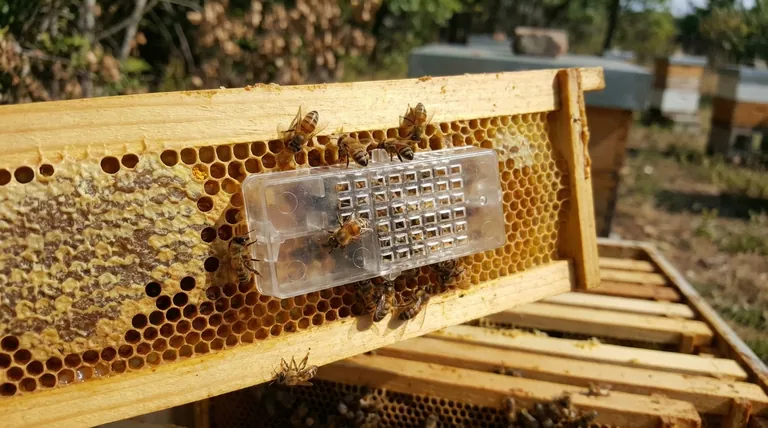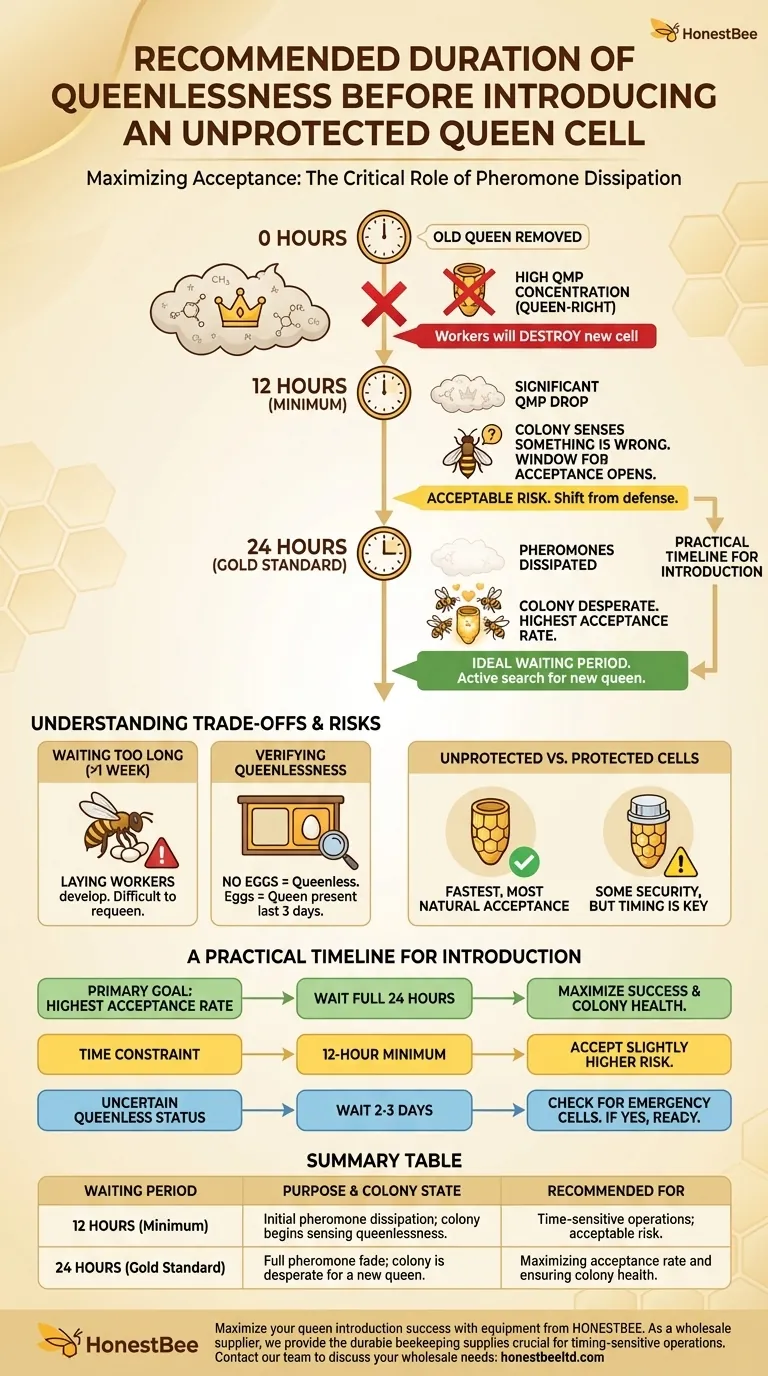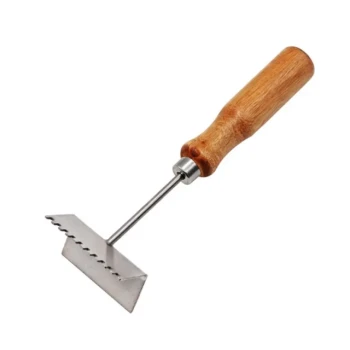To ensure the highest acceptance rate for a new queen cell, a colony must be verifiably queenless for a minimum of 12 hours before introduction. However, waiting a full 24 hours is the gold standard, as this period is critical for allowing the previous queen's chemical influence to fade, making the workers receptive to a replacement.
The core challenge is not just removing the old queen, but erasing her chemical signal. The 12-to-24-hour waiting period allows the old queen's pheromones to dissipate, shifting the colony's instinct from defending their queen to accepting a new one for survival.

The Critical Factor: Erasing the Queen's Scent
Introducing a new queen is fundamentally a chemical conversation with the hive. Success depends entirely on the colony believing it is in urgent need of a new monarch.
Understanding Queen Pheromones
A reigning queen produces powerful chemicals, primarily Queen Mandibular Pheromone (QMP). This scent spreads throughout the hive, signaling her presence, suppressing worker ovary development, and ensuring social cohesion.
As long as this pheromone is present at a high concentration, the workers will view any new queen or queen cell as a foreign rival and will almost certainly destroy it.
The 12-Hour Minimum
After 12 hours of queenlessness, the concentration of QMP begins to drop significantly. At this point, the workers start to perceive that something is wrong.
This is the absolute minimum time required for the colony to begin shifting its collective mood from "queen-right" to "queenless," creating a window for potential acceptance.
The 24-Hour Gold Standard
After 24 hours, the queen's pheromones have dissipated to a level where the entire colony is acutely aware of its orphaned state. Their behavior shifts from defense to desperation.
A colony in this state is not just willing to accept a new queen cell—it is actively seeking one. This makes 24 hours the ideal waiting period for maximizing your success rate.
Understanding the Trade-offs and Risks
While timing is the most important factor, a few other conditions can lead to the rejection of a perfectly good queen cell.
The Danger of Waiting Too Long
If a colony is left queenless for too long (typically more than a week), some worker bees may begin to develop their ovaries and lay unfertilized eggs.
Once laying workers are established, they are notoriously difficult to requeen. They will see any new queen or cell as a threat to their own reproductive status and will destroy it. The 24-hour window is a safe middle ground.
Verifying True Queenlessness
Before you start the clock, you must be absolutely certain the colony is queenless. This means no queen, no virgin queen, and no existing queen cells (unless you are replacing them).
The most reliable sign of queenlessness is the absence of eggs. If you see eggs, a queen was present in the last three days, and you must find her before proceeding.
Unprotected vs. Protected Cells
This advice is specific to unprotected queen cells, which are introduced without a plastic or foil covering. While protectors can offer some security against premature destruction, they are not a substitute for proper timing.
Achieving the right timing for introducing an unprotected cell results in the fastest and most natural acceptance by the worker bees.
A Practical Timeline for Introduction
Your approach should be dictated by your specific goals and how much risk you are willing to tolerate. Use this framework to make the best decision for your apiary.
- If your primary focus is the absolute highest acceptance rate: Wait the full 24 hours to ensure the old queen's pheromones have thoroughly dissipated and the colony is desperate for a replacement.
- If you are working under a significant time constraint: A 12-hour window is the minimum viable period, but you must accept a slightly higher risk of the bees rejecting the cell.
- If you are uncertain about the colony's queenless status: Wait 2-3 days after you believe the queen was removed. If the bees have started their own emergency cells on young larvae, it is a definitive sign they are queenless and ready for your new cell.
Proper timing transforms the introduction of a new queen from a gamble into a predictable and reliable step for ensuring long-term colony health.
Summary Table:
| Waiting Period | Purpose & Colony State | Recommended For |
|---|---|---|
| 12 Hours (Minimum) | Initial pheromone dissipation; colony begins sensing queenlessness. | Time-sensitive operations; acceptable risk. |
| 24 Hours (Gold Standard) | Full pheromone fade; colony is desperate for a new queen. | Maximizing acceptance rate and ensuring colony health. |
Maximize your queen introduction success with equipment from HONESTBEE.
As a wholesale supplier to commercial apiaries and distributors, we provide the durable, reliable beekeeping supplies you need to manage your hives effectively. Whether you're performing splits or requeening, having the right tools is crucial for timing-sensitive operations like queen cell introduction.
Let us help you build a stronger, more productive apiary. Contact our team today to discuss your wholesale needs and explore our product catalog.
Visual Guide

Related Products
- Professional Multi-Functional Queen Bee Cage
- Professional Bamboo Queen Isolation Cage
- Professional Round Push-In Queen Cage with Metal Tines
- Wood and Mesh Push-In Queen Cage
- Durable Galvanized Steel Spring Queen Bee Cage
People Also Ask
- How long does it typically take bees to adjust to a new queen? Master the 2-7 Day Acceptance Window
- How should a queen cage be maintained over time? Ensure Queen Introduction Success
- How do you check if the queen has been released after installation? A Guide to Successful Queen Acceptance
- What should be done before removing the queen cage from the hive? Ensure Your New Queen is Accepted & Laying
- What is sequestration, and how does it help bees reorient? A Safer Guide to Hive Relocation















